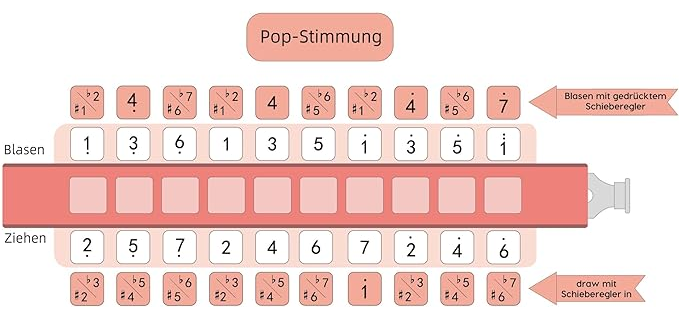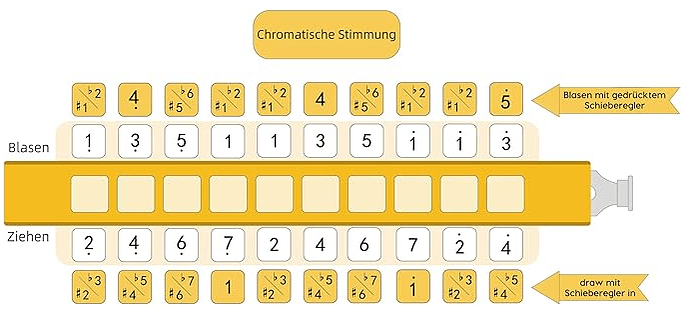Can someone explain difference between pop tuning and solo tuning? Which one is better for what? Or it’s just matter od preference? I have never played chromatics. Does solo tuning have any benefits over pop tuning when there are no full 3 chromatics octaves?
Hi @Adam1
Here is the note layout for all three models:
Solo Tuning
Pop Tuning

“Normal” Blues Harp Tuning

The Pop Tuning provides a full 3 octave chromatic range with no bending needed. The Solo Tuning gives you 2.5 chromatic octaves with no bending needed. The “advantage” for Solo Tuning might be if you already are comfortable with solo tuned chromatics because there is no new note layout to learn. If you have never played a chromatic, then there would be little or no advantage for you – in fact there might be a “disadvantage” because you have less range (2.5 octaves versus 3 full octaves) and you must learn the note layout.
Pop Tuning is more similar to a normal blues harp and would most likely be easiest for you to learn – at least if you are proficient with a blues harp and comfortable with its note layout.
Which is “best” for you is something that you must decide.
Regards,
– Slim ![]()
Just learning Chromatic myself, @Slim and @Jay1 are the people to ask about this also @Hogie.Harmonica
I want to be honest here, so no one gets a wrong impression: I too am just learning to play the chromatic harmonica whenever I have time. Most of my practice time is spent on other instruments.
– Slim ![]()
@Adam1 @Slim @Andy2 These days I only play chromatic and mainly as a when available part-time studio session player. I’ve never played any chromatic tuning other than solo tuning, it’s the standard set-up and when I originally started to play chromatic it was the only one readily available. There are now a number of different tuning options with what seems to be new ones almost monthly. As Slim has written Which is “best” for you is something that you must decide. but as much of the chromatic music, lessons, guidance, books and tabs are aimed at standard solo tuning in the key of C that should be taken into consideration as should your comfort level with a normal blues harp layout. A big advantage of solo tuning is that every 4 holes create one octave, once holes 1-4 are learned then the pattern follows on. My personal preference is 10 hole 2.5 octave solo tuned valveless, following that the 12 hole 3 octave valveless. I have 12 hole valved an 16 hole 4 octave valved chromatics but hardly ever use them but that’s my preference and is certainly not for everyone. Have a look at Harp On! Chromatic Harmonicas Description where there’s a lot of information. Whatever you decide enjoy playing chromatic, it’s different but worth the effort. Jay1
After reading so much about it here I just picked up an East Top Forerunner 2. My first reaction was that my it’s a big mouthful compared to a diatonic!
However that difference is handy in a way as it’s an extra signal to my subconscious processes that when I pick it up this is not a diatonic! ![]()
So with the key of C no matter of which tuning (pop or solo) i should be able to play anything in at least 2.5 ocstaves and it’s matter of habbit right? ![]() I thought there are some limitatiom that some positions are better played on solo tuning but it seems not.
I thought there are some limitatiom that some positions are better played on solo tuning but it seems not.
Thanks for great answers. @Slim, @Jay1
@Adam1 , I use forerunners as my standard 12 hole chromatic. Some positions are better played on chroms in different keys but C is a good starting point. I carry chroms in Ab; Bb; C; D; E; & F# because that also gives me solo tuned diatonics in those keys and with the slide held in usually signed as < A; <B; <Db; <Eb; <F; & <G, A solo tuned chrom is only two solo tuned diatonic joined by a button, As @ David W puts it they are heavier. I travel a lot and a 10 hole 2.5 octave chrom is a lot easier that 12 + diatonic (blues) harps to carry. 3rd position of draw 1 or draw 5 is pretty good for blues and the blues/pentatonic scales give you some useful get-me-out-of jail-free notes. If you look for CHROMATIC in the GEAR section on 4th October (think this may do it Chromatic - #8 by Jay1 ) I posted the whole list of blues; minor pentatonic & major pentatonic scales for a solo tuned C chrom. If you can put them into a small index notebook you’ll can use them as a cheat list so if someone is playing in Bb minor just turn to that page and it will be difficult to go wrong ![]() I’ve been cheating like that for years
I’ve been cheating like that for years ![]() Jay1
Jay1
Two thing I forgot to mention: Octaves are in 4 hole sequence so holes 1-4 are the first octave; 5-8 the second octave and on a 12 hole 9-12 are the 3rd octave and 10 hole chroms have a slightly different tuning on holes 9 & 10 but don’t worry about that. Jay1
could you guys provide a quick “for dummies” explanation: how would one use it, as in, where would one get the tabs? OR is it as simple as pressing the button in regular TABS places where bends, for example such as 3" are required?
Not sure I understand the question but you can’t use diatonic tabs for chromatics so you’d need to do a search for chromatic tabs. It will depend on how and what you play. If you only use tabs then chrom tabs are available with usually (but not always) the < indicating slide pushed in; if you use music then just follow the melody line if you play by ear or by listening then you’ll find when you need/want that half step (semitone) higher note, If you use pentatonic scales my ‘cheat sheets’ show the slide in sign of < for when the slide is required. With valveless chroms you can bend as with a diatonic. Remember that with solo tuned chroms you have the full western scale so for a C chrom it’s C +1; D-1; E+2; F-2; G+3; A-3; B -4 and C +4 then the pattern starts again on C +5 etc. etc. The slide in has the same pattern with sharps/flats starting with C# <+1 etc. etc. You’ll see that there’s a double C on 4 & 5 and on 12 hole chroms on 8 & 9 so at the end of one octave and the start of the next octave, I’ve tried to keep it simple but I’m not a good teacher if that doesn’t answer your question try me again. Playing chromatic is a lot easier than trying to explain it ![]()
![]() Jay1
Jay1
@Luke Luke, there seems to be a growing interest in chromatic harmonica. I’m a hopeless teacher and although trying to keep things simple they usually read as being more complicated than they really are. Do you know of or run any courses that might help those trying to come to terms with solo tuning because I’m sure that if solo tuned diatonic can be mastered playing chromatic will then fall into place? Jay1
Your a bit further along than I am tbh.
I just got the East Top forerunner mark one, tbh can’t really see much of a difference from the mark 2, I played along with a jump blues backing tracks in G and another in C yesterday, I made a few errors but I know If I keep at it I’ll get this. I’ve a few chores to do today but I’ll have another crack later on. Doing octaves on this sounds fantastic! I’ve seen a guy on YouTube who is learning step by step a bit each week so I’m going to give that a go
@Andy2 Like you I can’t see much difference between Forerunner 1 & 2 except the price ![]() Suspect F1 was to test the market and F2 the follow-up with more keys. What’s the YouTube who is doing the weekly learning, that may well help @yuriythebest; @Adam1; @Slim and any others who are looking at solo tuned chroms. or solo tuned diatonics? Sounds like you’re enjoying your Forerunners. Jay1
Suspect F1 was to test the market and F2 the follow-up with more keys. What’s the YouTube who is doing the weekly learning, that may well help @yuriythebest; @Adam1; @Slim and any others who are looking at solo tuned chroms. or solo tuned diatonics? Sounds like you’re enjoying your Forerunners. Jay1
I’d be interested in the link for that @Andy2 if you have it handy.
I can honestly say this guy who is doing the weekly warts and all learning is an amazing diatonic player and it shows him struggling along. But the beauty is a I watch the video through a few times and Understand what I’m doing I tend not to make those mistakes ( which fantastically is the point) but I am also able to extrapolate on the lessons and licks. I’ll post a thread on my experiences playing the chromatic as it may help people on here who are looking at playing this beast. I forgot to add the course he is learning along with I believe is the David Barrett course that Hohner offers online when you buy a chromatic harp off them.
Yes I will do that no problem @DavidW
I’m going have to open it as a new topic as it’s really difficult to upload on here
Hey bud! I haven’t logged on here in a while. Interesting about the DL test in the UK. I live in the states and as long as you pass the test you can drive whatever. There is no restriction between manual and automatic. Unless things have changed here. I got my license in ‘83 so it’s been a moon or two ago. Maybe things have changed? But my main question is how has bending been going since your post? I’m 16 months in and still having struggles mainly the 2 whole step and all of them on 3. 3 I tend to go straight to the step and a half. I’m seriously struggling landing on the half and whole step on 3. Errrg! Frustration city! Was just curious how it’s been going for ya with bending? I switched to tongue blocking 5 months in so that threw an additional curve into getting bending down for me. I close but unfortunately not quite where I need to be at this point. Work in progress I guess. Take care!
The thing that really unlocked 3 hole bends for me is a shruti box recording, droning that desired note, and improvising melody that treats that note as the root.
